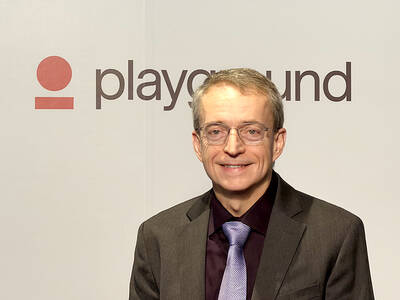Hon Hai Precision Industry Co Ltd (鴻海精密), the world’s biggest electronics manufacturing services provider, yesterday said it has sold a portion of its patent portfolio consisting of head-mounted display technology to Google Inc.
Hon Hai said in a statement its head-mounted display technology superimposes computer-generated images onto real-world scenes.
It did not disclose the financial terms of the deal.
The technology can be used in ground displays, engineering and scientific design applications, gaming and video devices as well as for training and simulation tools, the company said.
Hon Hai owns more than 5,000 patents.
The patent purchase is Google’s latest investment aimed at accelerating the development of Google Glass.
On July 22, Google signed an agreement with Tainan-based chipmaker Himax Technologies (奇景光電) to buy a 6.3 percent stake in its subsidiary, Himax Display Inc (立景光電), to help boost Himax Display’s chip capacity. The deal is expected to be completed this quarter.
Himax Display makes LCOS chips for head-mounted displays such as in Google Glass and in pico projectors.
Separately, Innolux Corp (群創光電), the nation’s top LCD panel maker, yesterday said it is developing new automotive displays, targeting the fast-growing demand primarily from luxury cars.
Innolux said its 10.25-inch cluster displays for cars uses low-temperature-polysilicon (LTP) technology and said the product has exceeded customer’s requirements.
Innolux also develops a full-color head-up display (HUD) that projects driving information directly into the driver’s line of sight, and halves the time it takes for eyes to shift focus from the road to the instruments and back, the company said.
The 1.8-inch HUD has passed qualification tests by some European customers and Innolux said it expected the product to have significant revenue contribution within two years.
Last year, Innoux shipped 9 million units of automotive displays, which counts BMW and Mercedez-Benz as its top clients.
Shen Ta-yi (沈大逸), a director at Innolux, said the company focuses on developing automotive displays as the market is growing by a double-digit percentage each year.
Innolux held a 16 percent share of global automotive display market last year, trailing behind Sharp Corp and Japan Displays Co, market researcher NPD DisplaySearch’s data showed.
In the first quarter of this year, the company shipped 3.28 million units, bringing its market share to 22.2 percent, surpassing Sharp’s 19.9 percent.

JITTERS: Nexperia has a 20 percent market share for chips powering simpler features such as window controls, and changing supply chains could take years European carmakers are looking into ways to scratch components made with parts from China, spooked by deepening geopolitical spats playing out through chipmaker Nexperia BV and Beijing’s export controls on rare earths. To protect operations from trade ructions, several automakers are pushing major suppliers to find permanent alternatives to Chinese semiconductors, people familiar with the matter said. The industry is considering broader changes to its supply chain to adapt to shifting geopolitics, Europe’s main suppliers lobby CLEPA head Matthias Zink said. “We had some indications already — questions like: ‘How can you supply me without this dependency on China?’” Zink, who also

The number of Taiwanese working in the US rose to a record high of 137,000 last year, driven largely by Taiwan Semiconductor Manufacturing Co’s (TSMC, 台積電) rapid overseas expansion, according to government data released yesterday. A total of 666,000 Taiwanese nationals were employed abroad last year, an increase of 45,000 from 2023 and the highest level since the COVID-19 pandemic, data from the Directorate-General of Budget, Accounting and Statistics (DGBAS) showed. Overseas employment had steadily increased between 2009 and 2019, peaking at 739,000, before plunging to 319,000 in 2021 amid US-China trade tensions, global supply chain shifts, reshoring by Taiwanese companies and

Taiwan Semiconductor Manufacturing Co (TSMC, 台積電) received about NT$147 billion (US$4.71 billion) in subsidies from the US, Japanese, German and Chinese governments over the past two years for its global expansion. Financial data compiled by the world’s largest contract chipmaker showed the company secured NT$4.77 billion in subsidies from the governments in the third quarter, bringing the total for the first three quarters of the year to about NT$71.9 billion. Along with the NT$75.16 billion in financial aid TSMC received last year, the chipmaker obtained NT$147 billion in subsidies in almost two years, the data showed. The subsidies received by its subsidiaries —

OUTLOOK: Pat Gelsinger said he did not expect the heavy AI infrastructure investments by the major cloud service providers to cause an AI bubble to burst soon Building a resilient energy supply chain is crucial for Taiwan to develop artificial intelligence (AI) technology and grow its economy, former Intel Corp chief executive officer Pat Gelsinger said yesterday. Gelsinger, now a general partner at the US venture capital firm Playground Global LLC, was asked at a news conference in Taipei about his views on Taiwan’s hardware development and growing concern over an AI bubble. “Today, the greatest issue in Taiwan isn’t even in the software or in architecture. It is energy,” Gelsinger said. “You are not in the position to have a resilient energy supply chain, and that,